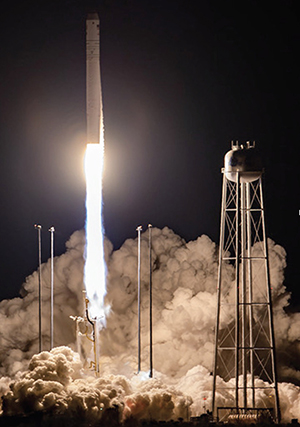By Linda Cicoira
Northrop Grumman’s Cygnus spacecraft arrived on schedule Monday at the International Space Station carrying about 7,400 pounds of cargo that was launched from the Mid-Atlantic Regional Spaceport at the NASA Wallops Flight Facility late last week.
The rocket was loaded with science and research, crew supplies, and vehicle hardware. It was the company’s 10th cargo delivery flight.
Expedition 57 astronauts Serena Aunon-Chancellor of NASA and Alexander Gerst of the European Space Agency used the space station’s robotic arm to secure Cygnus at 5:28 a.m.
The cargo will support dozens of new and existing investigations as Expeditions 57 and 58 contribute to about 250 science and research studies. Highlights include a demonstration of 3D printing and recycling technology and simulating the creation of celestial bodies from stardust.
“The Refabricator is the first-ever 3D printer and recycler integrated into one user-friendly machine,” according to a NASA report. “Once it’s installed in the space station, it will demonstrate recycling of waste plastic and previously 3D printed parts already on-board into high-quality filament — 3D printer ink. This recycled filament will then be fed into the printer to make new tools and parts on-demand in space. This technology could enable closed-loop, sustainable fabrication, repair, and recycling on long-duration space missions, and greatly reduce the need to continually launch large supplies of new material and parts for repairs and maintenance.”
“The Experimental Chondrule Formation will explore how planets, moons and other objects in space formed by simulating the high-energy, low-gravity conditions that were present during formation of the early solar system,” the report continued. “Scientists plan to zap a specially formulated dust with an electrical cur-rent, and then study the shape and texture of the resulting pellets.”
Another project “grows large crystals of an important protein, leucine-rich repeat kinase 2 in microgravity for analysis back on Earth. This protein is implicated in the development of Parkinson’s disease. Knowledge of its structure may help scientists better understand the pathology of the disease and develop therapies to treat it. The … crystals grown in gravity are too small and too compact to study, making micro-gravity an essential part of the research.”
The Cygnus spacecraft will remain at the space station until February before its destructive reentry into Earth’s atmosphere, disposing of several thousand pounds of trash. “This is the seventh flight of an enhanced Cygnus spacecraft, and the fourth using Northrop Grumman’s upgraded Antares 230 launch vehicle featuring new RD-181 engines that provide in-creased performance and flexibility.”
The spacecraft for this mission was named in memory of astronaut John Young, who was selected for NASA’s second astronaut class and flew during the Gemini, Apollo, and Space Shuttle pro-grams. He walked on the Moon during Apollo 16 in 1972. And he commanded the first space shuttle mission in 1981.
For more information about the ISS, visit https://www.nasa.gov/station
Sign in
Welcome! Log into your account
Forgot your password? Get help
Password recovery
Recover your password
A password will be e-mailed to you.



